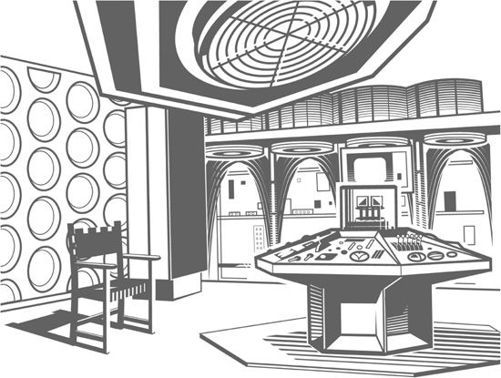Recall Circuit – Can forcibly return a TARDIS to Gallifrey. (Arc of Infinity) Reliability Rating:
Scanner – Allows the TARDIS crew to observe what’s happening outside the ship (An Unearthly Child) Reliability Rating:
Telepathic Circuits – Allows telepathic contact between different TARDISes as well as Gallifrey. (The Time Monster) Reliability Rating:
Telephone – able to receive calls from across space and time. (World War Three) Reliability Rating:
Time Space Visualiser – Not strictly an original TARDIS component but salvaged from the Space Museum. Allows the TARDIS crew to view any event in history. (The Chase) Reliability Rating:
Time Path Indicator – Informs the pilot if another time craft is following the TARDIS’s temporal pathway. (The Chase) Reliability Rating:
Time Scanner – Lets you know where you’ll arrive next – and what monsters you might meet! (The Moonbase) Reliability Rating:
Time Sensor – Detects disturbances in a time field – or a TARDIS sniffer-outer, as Jo Grant put it. Only works in Venusian miles. (The Time Monster) Reliability Rating:
Time Vector Generator – Similar to the Dimensional Control, stabilises the TARDIS’s dimensional transcendence. (The Wheel in Space) Reliability Rating:
Translation Circuits – Linked to telepathic circuits. Translates most languages into the individual language of the TARDIS crewmembers. Also works on the written word. Doesn’t do Gallifreyan. (The End of the World) Reliability Rating:
Tribophysical waveform macro-kinetic extrapolator – Allows the TARDIS to project force fields around itself. (Boom Town) Reliability Rating:
Visual Stabilisation Circuit – Renders the TARDIS invisible if deactivated. (The Invasion) Reliability Rating:
Vortex Drive – Creates anti-gravity spirals which operate like tractor beams. (Delta and the Bannermen) Reliability Rating
Yearometer – Indicates the year in which the TARDIS has landed. (An Unearthly Child) Reliability Rating:
Zeiton-7 – Rare ore used by the TARDIS transpower system. (Vengeance on Varos) Reliability Rating:
OTHER EQUIPMENT:
Briode Nebuliser (The Two Doctors)
Conceptual Geometer (The Horns of Nimon)
Dynamorphic generator (Time-Flight)
Emergency Power Booster Unit (The Mind Robber)
Friction Contrafibulator (Vincent and the Doctor)
Image Translator (Full Circle)
Lateral Cones (The Visitation)
Light-speed Overdrive (Logopolis)
Nexial Tracers (The Face of Evil)
Orthogonal Vector (The Curse of the Black Spot)
Parametric Engines (The Curse of the Black Spot)
Seat Belts (Timelash)
Subneutron Circuits (Shada)
Synchronic Feedback Checking Circuit (The Pirate Planet)
Temporal Stabiliser (Planet of Fire)
Thermocouplings (Space / Time)
Vortex Shield (Shada)
Wibbly Lever (Space / Time)
Zig-Zag Plotter (The Lodger)
HOW TO GROW A TARDIS
A deleted scene from Journey’s End would have revealed that it is possible to grow a new TARDIS from a chunk of original TARDIS coral. Unfortunately, the process takes thousands of years. However, this can be sped up if you:
Shatterfry the plasmic shell
Modify the dimensional stabiliser to a foldback harmonic of 35.3.
Do this right and you’ll accelerate growth by the power of 59.
THE TIME ROTOR
Think you know the Time Rotor? It’s the central column in the middle of the console, right? Wrong! The Time Rotor is first mentioned during The Chase when the TARDIS approaches the Empire State Building. Vicki points to a unit near the door switch on the console itself, not the column, telling the Doctor that the Time Rotor is slowing down.
In fact, the central column is mentioned earlier, in The Edge of Destruction, where the Doctor explains that the heart of the machine is kept beneath the ‘Control Column’. There’s another brief mention of the Time Rotor in Meglos, but in Logopolis the Doctor clearly identifies the column as – wait for it, hair-splitters – ‘the time column’.
It was only later, through such books as The Doctor Who Technical Manual by Mark Harris and Peter Haining’s Doctor Who – A Celebration, that the rotor began to be completely associated with the column.
And what of the Time Rotor’s origins? Well, the device was invented by Terry Nation for his 1965 book, The Dalek Pocketbook and Space Traveller’s Guide. The device, he explained, let the Doctor know when the TARDIS was about to land. The same year, the Dalek creator included it in his script for The Chase.
CONSOLE ROOM DESIGNERS
Over the years, the TARDIS control room set has regenerated almost as many times as the Doctor himself…


The console room introduced in The Snowmen measures 48 feet in diameter and 28 feet high. The six sections of the new console itself each have different functions: time coordination, communications, information centre, power control and helm, power setting, and cerebral connection.
DIRECTIONS TO THE TARDIS WARDROBE
Head out of console room (coral desktop version). Take first left, then second right.
Take third left then head straight ahead.
Go under the stairs.
Pass the bins.
The wardrobe is fifth door on the left.
SOME TARDIS DISGUISES
‘It’s still a police box. Why hasn’t it changed? Dear, dear, how very disturbing.’
The Doctor, An Unearthly Child
Those clever old Time Lords, disguising their TARDISes to blend into the background… well, most of the time. Here are some of the forms various TARDISes have been seen to take: